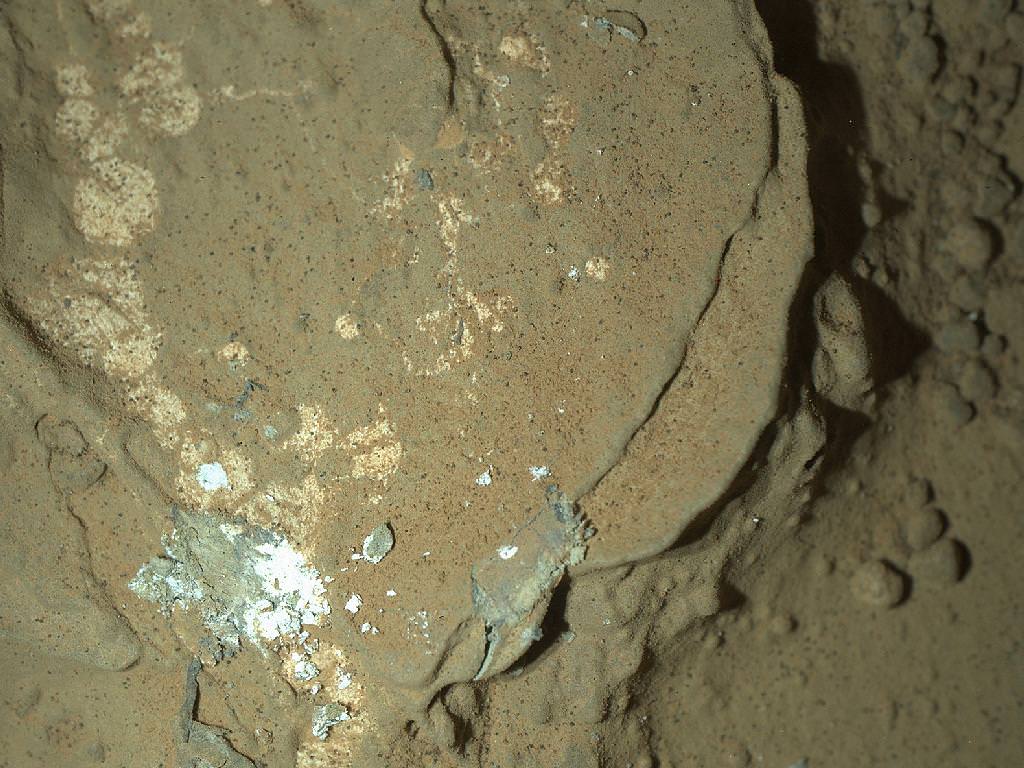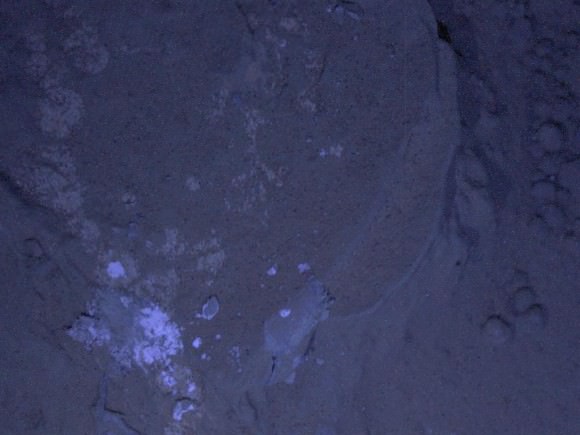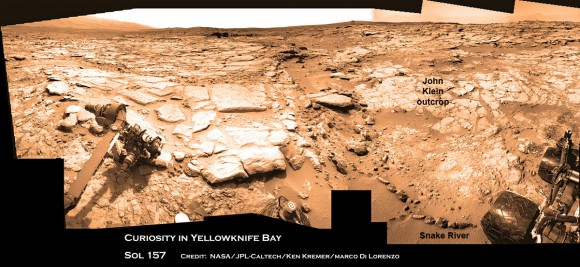Image caption: This image of a Martian rock illuminated by white-light LEDs (light emitting diodes) is part of the first set of nighttime images taken by the Mars Hand Lens Imager (MAHLI) camera at the end of the robotic arm of NASA’s Mars rover Curiosity. The image was taken on Jan. 22, 2013, after dark on Sol 165. It covers an area about 1.3 inches by 1 inch (3.4 by 2.5 centimeters). Credit: NASA/JPL-Caltech/MSSS
Curiosity’s high resolution robotic arm camera has just snapped the 1st set of night time images of a Martian rock of the now 5 1/2 month long mission – using illumination from ultraviolet and white light emitting LED’s. See the images above and below.
The Mars Hand Lens Imager (MAHLI) camera is located on the tool turret at the end of Curiosity’s 7 foot (2.1 m) long robotic arm.
MAHLI took the close-up images of a rock target named “Sayunei” on Jan. 22 (Sol 165), located near the front-left wheel after the rover had driven over and scuffed the area to break up rocks in an effort to try and expose fresh material, free of obscuring dust.
“Sayunei” is at the site of the “John Klein” outcrop in “Yellowknife Bay” where the team hopes to commence the 1st rock drilling operations here in the coming days. Curiosity drove a few meters several sols ago to reach “John Klein”.
See below our Sol 157 mosaic showing the “John Klein” outcrop – where the rover snapped these night images of “Sayunei”.
Image caption: This image of a Martian rock illuminated by ultraviolet LEDs (light emitting diodes) is part of the first set of nighttime images taken by the MAHLI camera on the robotic arm. The image was taken on Jan. 22, 2013, after dark on Sol 165. It covers an area about 1.3 inches by 1 inch (3.4 by 2.5 centimeters). Credit: NASA/JPL-Caltech/MSSS
“The purpose of acquiring observations under ultraviolet illumination was to look for fluorescent minerals,” said MAHLI Principal Investigator Ken Edgett of Malin Space Science Systems, San Diego. “These data just arrived this morning. The science team is still assessing the observations. If something looked green, yellow, orange or red under the ultraviolet illumination, that’d be a more clear-cut indicator of fluorescence.”
Analysis is still in progress to determine whether fluorescent minerals are present. Certain classes of organic compounds are also fluorescent.
MAHLI is an adjustable focus camera that works over a wide range. It can focus on targets just a few centimeters away or on distant objects like Mount Sharp, over 6 miles (10 km) away.
The LED’s surround the MAHLI lens.
Curiosity has discovered widespread evidence for the ancient flow of liquid water at “Yellowknife Bay” in the form of water bearing mineral veins, cross-bedded layering, nodules and spherical sedimentary concretions.
Image caption: Curiosity found widespread evidence for flowing water in the highly diverse, rocky scenery shown in this photo mosaic from the edge of Yellowknife Bay on Sol 157 (Jan 14, 2013). The rover will soon conduct 1st Martian rock drilling operation at flat, light toned rocks at the outcrop called “John Klein”, at center, the site where she is now located. ‘John Klein’ drill site and ‘Sheep Bed’ outcrop ledges to right of rover arm are filled with numerous mineral veins and spherical concretions which strongly suggest precipitation of minerals from liquid water. ‘Snake River’ rock formation is the linear chain of rocks protruding up from the Martian sand near rover wheel. Credit: NASA/JPL-Caltech/Ken Kremer/Marco Di Lorenzo




Other stuff that fluoresces: organisms.
Curiosity has life detection equipment, and _now_ they tell us!? Next up from NASA-oh-did-I-forgot-tell-you releases: rovers comes with preinstalled driver’s licence.
They better should have fitted the proposed Raman spectrometer (http://mepag.nasa.gov/meeting/apr-06/Raman_instrument_Mepag_4_061.pdf) on this behalf but yes I too eagerly awaited the first use of the nighttime observation capabilities of the MAHLI system using UV illumination (black light). Most properly this will become the most interesting aspect of the mission if they encounter some manifestation of Martian life on the macro scale like lichen grow for instance. Really looking forward to a routine usage of this capability of MSL!
At first glance it looks like this first observation supports the detection of calcium bearing material like gypsum by the other instruments which yield a whitish fluorescence effect at long wave UV illumination…
The image was taken on January 22, 2012? You must mean 2013 (Sol 165). Thanks for the update.